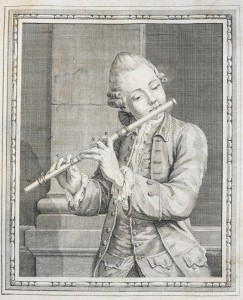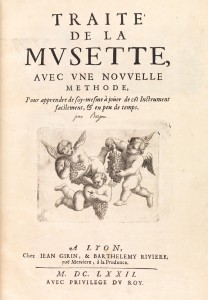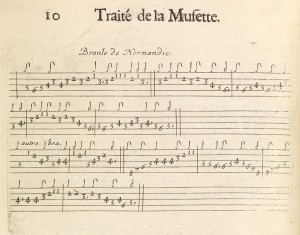Discovering the musette: a 17th century treatise on a little known musical instrument
The Rare Music Collection includes a number of early instrumental methods and treatise, volumes which offer instruction on how to play a musical instrument and how to interpret musical notation, and/or information about the instrument’s history and technical development. Notable early treatises in the Collection for Spanish guitar and flute respectively are Gaspar Sanz’s Instruccion de musica sobre la guitarra Española… (Zargosa, 1674) and Jacques Hotteterre, Méthode pour apprendre a jouer en très peu de tems de la flûte traversière … (Lyon, 1765, 1781 issue).

A third early treatise is the Traite de la musette … (Lyon, 1672), the full title of which translates as “Treatise of the musette with a new method for learning to teach yourself to play this instrument easily and quickly”. The musette is no longer well-known, but this beautiful leather-bound volume, with its own marbled slipcase, invites the curious to explore.
early treatise is the Traite de la musette … (Lyon, 1672), the full title of which translates as “Treatise of the musette with a new method for learning to teach yourself to play this instrument easily and quickly”. The musette is no longer well-known, but this beautiful leather-bound volume, with its own marbled slipcase, invites the curious to explore.
Neither the bucolic frontispiece nor the full title page, with its vignette of three putti with bunches of grapes, has the elusive musette at front and centre. The frontispiece was engraved by Nicolas Auroux after drawings by eminent French painter Thomas Blanchet (1614-89) as were, mostly likely, the putti. [1]

The frontispiece shows a shepherd/musician seated near a ruined aqueduct playing an hautboy (oboe). Seven other wind instruments are somewhat improbably propped up or scattered around him. [2] At some distance we see another shepherd playing another oboe to his herd of goats. In order to locate the musette in the engraving we must look at the left foreground where it sits on a low, flat rock. The musette of the treatise’s title, then, is a type of small bagpipe. You can see its cylindrical drone (to the left), the bag in the middle with separate bellows tucked underneath and a chanter (or chalumeau) attached. A chalumeau simple (with windcap) is propped up above the drone. [3]
The author of this treatise was Pierre Borjon de Scellery (1633-91), a lawyer, parliamentarian and amateur musician. While he promises to leave his readers able to teach themselves to play, de Scellery instead spends much of his short volume expounding on the instrument’s history and antecedents. At the back of the volume there are, however, some dances and popular tunes to play on the musette, notated with both conventional five-line stave notation and in tablature, where numbers indicate which holes should be covered by the fingers; the instrument has a “closed” fingering system.

Evidence of how the musette de cour was held and played, and by whom, is found in a portrait by Hyacinthe Rigaud of nobleman and lawyer, Gaspard de Gueidan (1738; held Musée Granet, Aix-en-Provence). The instrument, here richly decorated, was held with the bellows tucked under the forearm and pumped to inflate the bag and sound both the drone and the melody played on the chanter; we know that the instrument’s sound was neither harsh nor overly loud. The musette then was played by noble amateurs as well as the musicians at the royal court; it was also, unquestionably, an instrument compatible with courtly elegance.
Jennifer Hill, Curator, Music
[1] Lucie Galactéros-de Boissier, Thomas Blanchet (1614-1689), Paris: Arthéna, 1991, 476-478.
[2] To identify all the instruments see, for example, http://www.rimab.ch/content/bilddokumente/GE/borjon-de-scellery-pierre-1633-1691-traite-de-la-musette-frontispiz-1672
[3] James B. Copp, “Before Borjon: The French Court Musette to 1672”, Galpin Society Journal, 58 (May 2015), 3-5.
Categories
- Uncategorised
- Rare Music

Leave a Reply